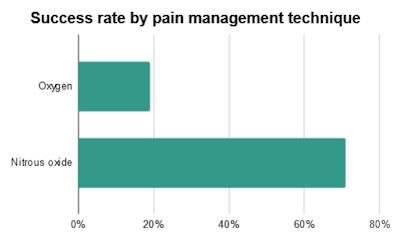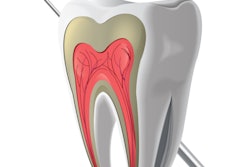
A combination of nitrous oxide and ibuprofen may help dull the pain of children undergoing vital pulp therapy for irreversible pulpitis. A new study found that the combination significantly bolstered children's pain relief compared with those who received ibuprofen alone.
Pain management for irreversible pulpitis in children's permanent teeth can be difficult, but it is also essential, according to the authors, led by Papimon Chompu-inwai, DDS, from the Division of Pediatric Dentistry at Chiang Mai University in Thailand. Their findings were published in the fall edition of Anesthesia Progress (Fall 2018, Vol. 65:3, pp. 156-161).
"In pediatric patients, preventing pain by administering pre-emptive analgesia and/or sedation should be greatly beneficial because inadequate pain control, especially in this group of patients, could lead to failure in behavior management, a negative experience for the patient, and a poor treatment outcome," the authors wrote.
Achieving adequate pain relief
Adequate pulpal anesthesia can be difficult for any patient with irreversible pulpitis. However, it is even more challenging for children because young permanent teeth have larger pulp and more extensive blood and nerve supplies than older permanent teeth, according to the authors. Since nitrous oxide and ibuprofen target different pain pathways, the researchers hypothesized that a combination of the two may help prevent severe pain in children and adolescents with irreversible pulpitis.
Therefore, they conducted a single-blind study with 33 children ages 6 to 18 undergoing vital root therapy for symptomatic irreversible pulpitis in a permanent molar. All children were given an appropriate dose of ibuprofen syrup for their weight one hour before the procedure. Then, at the outset of the procedure, about half of the children received nitrous oxide, while the other half received ibuprofen as a control.
At multiple time points during the experiment, the children rated their pain using a scale from 0 to 10, where 0 indicated they did not feel any pain and 10 indicated the worst pain they had experienced. The researchers considered the pain management technique to be a failure if patients reported pain at level 6 or higher at any point during the treatment.

Nearly three-quarters of children who received the combination of ibuprofen and nitrous oxide reported adequate pain management for the entire treatment, compared with only 19% of children in the oxygen group who reported adequate pain management.
“The search for other approaches for adequate pulpal anesthesia is highly recommended.”
Furthermore, the success rate for children who received ibuprofen was much lower than the success rate of similar studies with older patients, the authors noted. They hypothesized that this may be because younger patients have more fear and anxiety, as well as have teeth that can be more sensitive to pain.
"Consequently, only one intervention, such as premedication with ibuprofen alone, may become inadequate in managing anesthesia in this group of patients," they wrote. "Thus, the search for other approaches for adequate pulpal anesthesia is highly recommended."
Larger studies still needed
The study had a number of shortcomings, including that the operator knew which children were given nitrous oxide and which were given oxygen. Furthermore, the study was relatively small with only 33 patients.
Nevertheless, the difference in success between the intervention and control groups was large enough to make the results statistically significant, and the authors hope more researchers will follow-up on their work.
"With 16 and 17 samples in each group, this study seems to have adequate power to detect the difference of success of at least 35% or more," the authors wrote. "However, a larger sample size should be considered in further studies."



















